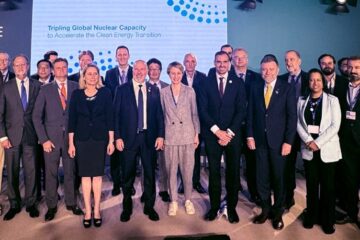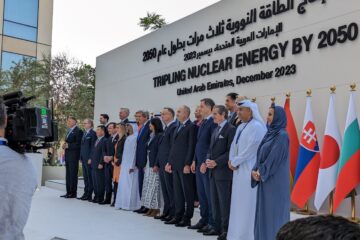The nuclear renaissance gathers steam…….the importance of Southern Company receiving its COL for Plant Vogtle.
If 2011 was all about the events at Fukushima, 2012 is shaping up to be a big year in moving forward with the nuclear renaissance.
For the Chinese, this is the year of the dragon. This is, in fact, the major symbol of good fortune in Chinese Astrology. Of the 12 signs of the Chinese zodiac dragon is the most special, as it is a mystical being rather than an earthly animal. In this context that means we can expect grand things this year. Bigger than life is very much a dragon thing.
And bigger than life is what was achieved last week – the granting of the COL for Plant Vogtle in Georgia – the first COL ever granted under the NRC process and the first license issued for a new nuclear plant in the USA in over 30 years.
We have been writing for some time now on how the nuclear industry is moving from west to east with China and India having more than 50% of the new plants under construction and planned while they only have 3% of the current nuclear capacity. This shift is important but so is the restarting of nuclear new build in the established nuclear countries of the west. Of the over 400 plants in operation globally about half of them are in Europe and one quarter are in the United States alone. With 104 plants in operation, the US by far has the world’s largest nuclear operating fleet.
Recent global decisions are starting to show a broad based nuclear renaissance with new build finally taking hold in the west. In the UK, regulators have granted interim design acceptance of both Areva/EDF’s UK EPR and Westinghouse’s AP 1000; and planning application from EDF Energy for Hinkley C was accepted late in 2011. More recently Finland accepted bids for its next nuclear plant following the first of a kind EPR under construction at Olkiluoto; and the French have embraced life extension for the current fleet and the French regulator has has given its preliminary approval of the safety options for the Atmea1 reactor design. So even without the good news in the US last week, nuclear power is alive and well in the western world.
So why is the granting of the COL for Plant Vogtle so important to the future of the industry? First of all, it clearly demonstrates that the US, the world’s largest nuclear operator remains committed to nuclear power going forward and what can be more important for the industry than that? With the COL for SCANA’s Summer plant expected to follow shortly, there will be five nuclear units under construction in the US including TVA’s Watt’s Bar 2 which is nearing completion. TVA also plans to complete its idled Belefonte plant.
It is somewhat unfortunate that in its decision to grant the COL, the chairman of the NRC was the sole abstaining vote – still overly focused on the impact of Fukushima, wanting conditions related to post Fukushima improvements added to the license. To their credit, the remaining commissioners felt differently with Kristine Svinicki stating “There is no amnesia individually or collectively regarding the events of 11 March 2011 and the ensuing accident at Fukushima.” She added that NRC staff did not recommend and did not support Jazcko’s idea of a condition being attached to the licence, “because we found it would not improve our systematic regulatory approach to Fukushima, nor would it make any difference to the safety of operating or planned reactors.”
It is interesting that just a few days earlier, a NRC sponsored long running study concluded “A severe accident at a US nuclear power plant would not be likely to cause any immediate deaths, while the risks of fatal cancers caused by such an accident would be millions of times lower than the general risks of dying of cancer”. This study is very important going forward because as we have written before, while Fukushima has been a terrible accident, the actual consequence to human life of radiation releases has been very modest with no immediate deaths and no longer term deaths expected.
Now the other issue, again as we have written about in the past, is the price of gas. Recent prices have been below $2.50 mmBTU – which is making it even more difficult for any alternative form of generation to gas to be economic. So what does this mean for future commitments to nuclear power in North America? Well, while gas prices are low right now, the gas industry is not without its own issues. Recent studies are suggesting that at today’s prices, gas companies are losing money and that the cost of subsequent shale fields will continue to rise. And of interest is new study reported in Nature magazine suggesting that with fracking, the carbon footprint of gas is becoming similar to coal, rather than half that of coal as it is for conventionally produced gas. Now I don’t want to start a big conversation on the future of gas – the issue is that nothing is perfect and we can expect gas to have its issues as well.
So what’s the next step? The industry needs to remain focused. The cost of gas is not within our control. However, delivering on our promises is! After delays in Olkiluoto 3 and Flamanville, it is essential for the new US projects to be successful – meaning achieving costs and schedules. As stated by Southern CEO Tom Flannery “We are committed to bringing these units online to deliver clean, safe and reliable energy to our customers. The project is on track, and our targets related to cost and schedule are achievable.” Good luck Tom. These units will be the 5th and 6th AP1000s to be built and we know that the first units in China are on schedule. The industry is behind you and we are counting on you to make this project a success demonstrating that plants built in the west can indeed meet targets and be important parts of our future generation mix.





1 Comment
J.F. Kelly · February 24, 2012 at 5:30 am
Useful to see this consolidation of positive developments for the nuclear power industry. It feels, perhaps, as though planets have had to be dragged to get to this point – so three cheers for the COL process too.
It is very useful to see in this piece the two NRC quotes which had not come up on my radar screen. The one from Commissioner Svinicki is quite potent as a message about the strength of the US nuclear regulatory review system (though licensees may argue).
A ‘Fukushima Condition’ on the COL would have been reminiscent of the sort of ill-considered, last minute compromises that get slapped onto international treaties and agreements just to keep noisy parties happy, with it being later realized that these ‘supplementary conditions’ are paradoxical, contradictory or just unworkable. Mercifully avoided in this case.
Comments are closed.